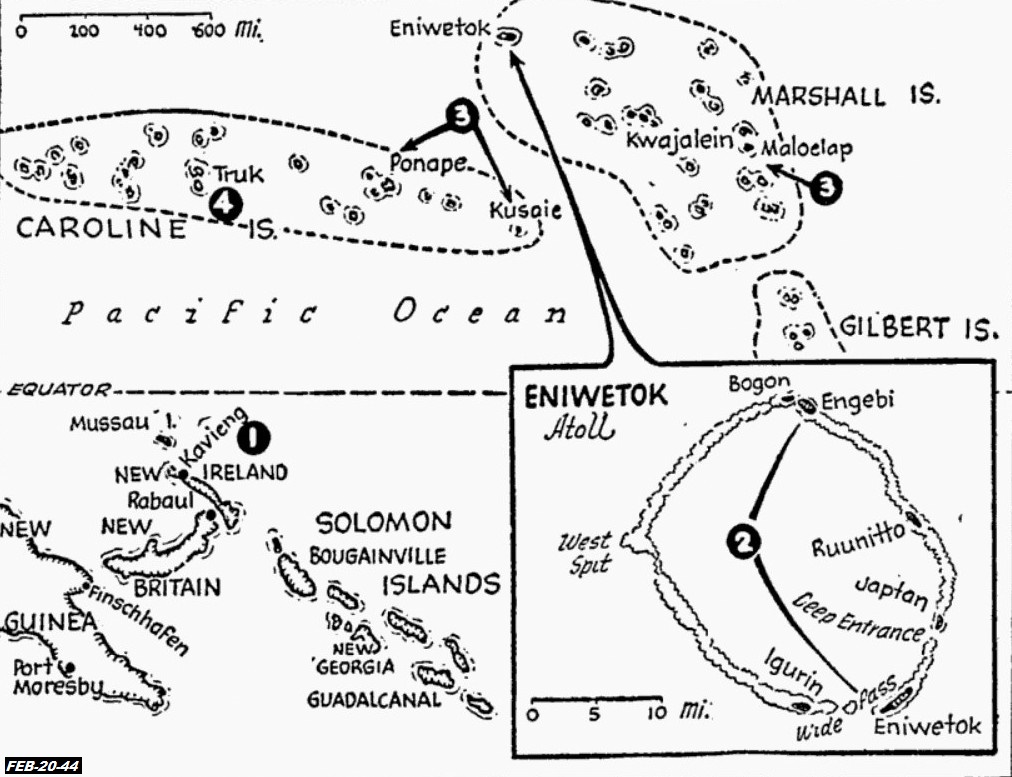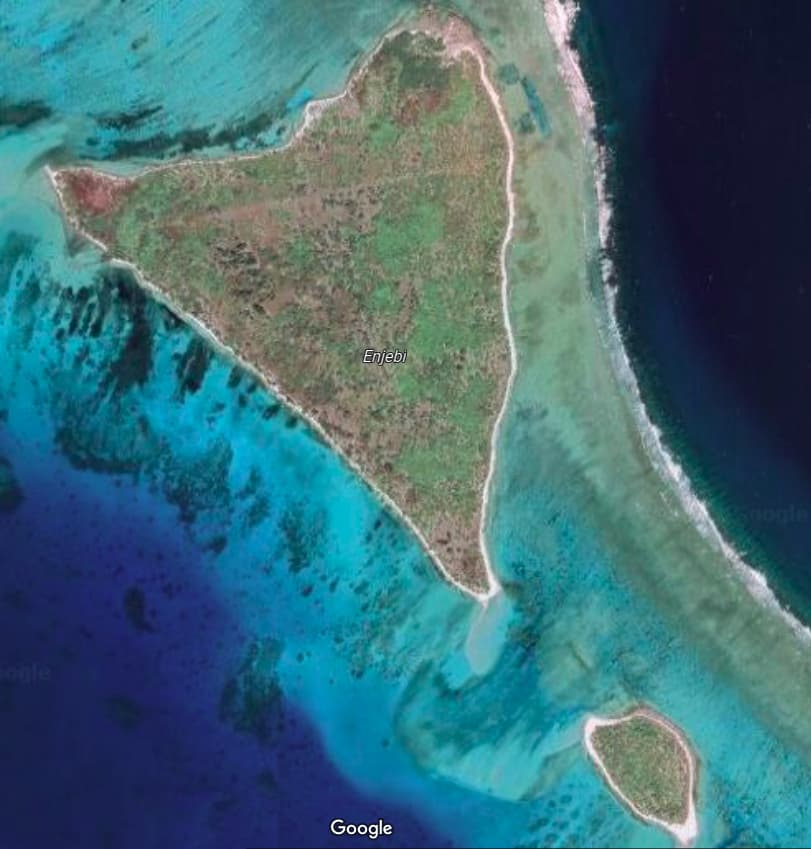The Pittsburgh Press (February 20, 1944)
RABAUL SHELLED FOR FIRST TIME; YANKS SEIZE MARSHALLS AIR BASE
Great offensive rips Jap islands over wide area
U.S. warships also bombard Kavieng, New Ireland; air, sea forces extend attack range in mid-Pacific
The United States’ first great offensive of the Pacific War raged in full fury Saturday night with hundreds of warships and thousands of troops and planes spreading death and ruin through Japan’s strongest ocean bases from the mid-Pacific Caroline and Marshall Islands to Rabaul and Kavieng in the Southwest Pacific.
Adm. Chester W. Nimitz’s Pacific Fleet headquarters announced that U.S. invasion forces had captured the Engebi air base and several other islets in the northern part of Eniwetok Atoll, westernmost of the Marshalls.
Gen. Douglas MacArthur reported that U.S. warships had carried out the first bombardment of the war on the once-great bastion at Rabaul and its companion bases at Kavieng, New Ireland.
Adm. Nimitz revealed that between Monday and Friday, U.S. surface forces repeatedly bombarded Japanese positions in the eastern Marshalls, while U.S. Army Liberators pounded Ponape, and Kusaie in the Carolines.
Spreading death and ruin on Jap bases over a wide area, the Pacific offensive against the Japs was highlighted by the first shelling (1) of Rabaul, New Britain, and Kavieng, New Ireland, and the Yank capture of the air base on Engebi (2) in the Eniwetok Atoll of the Marshalls. Extending their striking range hundreds of miles, Army planes bombed islands in the Eastern Carolines and U.S. warships bombarded a number of points in the Eastern Marshalls (3). The Navy was silent on the air attack on Truk (4), but there were indications it might be continuing.
Atoll invaders take islets
By William F. Tyree, United Press staff writer
Pearl Harbor, Hawaii – (Feb. 19)
U.S. troops have captured Engebi Air Base and several other islets in the northern part of Eniwetok Atoll in the Marshalls and powerful U.S. sea and air forces, roving over hundreds of miles of the Pacific, are neutralizing remaining Japanese strongholds in the Marshall and Caroline Islands, it was announced today.
A Pacific Fleet headquarters announcement said first reports indicated our casualties on Eniwetok have been light.
There was no specific word on the aerial assault started against the powerful Jap stronghold of Truk in the Carolines, but an earlier announcement from Adm. Chester W. Nimitz said aero-naval operations elsewhere in the Marshalls and Carolines were “supplementing the major attacks on Truk and Eniwetok.”
Truk attack decisive
This was a strong indication that the Truk attack, if not continuing, had resulted in a perhaps-decisive blow at Jap installations at the enemy’s South Pacific “Pearl Harbor.”
The fleet communiqué said that assaults on other portions of the shield-shaped Eniwetok Atoll at the western end of the Marshalls chain were proceeding according to a clockwork schedule that was fitting into the lightning conquest pattern of Kwajalein.
Engebi, the main air base on Eniwetok, is a triangular-shaped islet, 2,000 yards long by 1,500 yards wide, and has an excellent airstrip which had been virtually neutralized by the Allied aerial hammering of the last month.
Taken by first waves
Strategic islets in the vicinity include Bogon, Muzzinbaarkku and Kirinian, all small strands which presumably fell to the first waves of U.S. Marine and infantry troops.
Meanwhile, leaving no doubt that thousands of men and planes and hundreds of ships were at Adm. Nimitz’s command, detached forces – each powerful in its own right – were roving the length and breadth of the Carolines and Marshalls apparently unchallenged by Jap sea or air forces.
Between Monday and Friday, U.S. warships repeatedly shelled important enemy positions in the Eastern Marshalls and Army Liberators Thursday in a new long-range blow battered warehouses and docks at Ponape, in the Carolines, 372 miles east of Truk.
The Liberators also blasted Kusaie, the easternmost island of the Caroline group.
The Japs identified one of the Eastern Marshalls’ targets as Maloelap, which has on Taroa Islet the most important enemy air base in that area. An enemy broadcast said Taroa was bombed and shelled Thursday.
Wednesday and Thursday, coinciding with the Eniwetok landings, the Central Pacific skies were filled with U.S. planes.
Liberators, Dauntless dive bombers and Warhawks of the 7th Army Air Force attacked four atolls in the Eastern Marshalls, the announcement said.
At one enemy base, Warhawks exploded a fuel dump and damaged a small cargo vessel as well as sinking three smaller craft.
Big patrol planes of Fleet Air Wing Two bombed ground installations at two other islands in the Marshalls Wednesday and Navy search planes hit two additional ones.
Repeated shellings
The announcement said:
Between Feb. 14-18, our warships repeatedly shelled important enemy positions in the Eastern Marshalls.
Results of the Truk attack were eagerly awaited here as it seemed no doubt the U.S. fleet had struck a stunning blow at the enemy stronghold in an operation proving U.S. ability to control the sea 3,000 miles from Pearl Harbor.
Jap broadcasts said the attack on Truk was apparently designed to drive a “wedge into the strategic key line” in the Central Pacific and that the war “has now entered the decisive stage with the enemy making a bold frontal attack against our vital key base.”
Just as at Kwajalein, RAdm. Turner’s forces did not go ashore on Eniwetok, 350 miles to the northwest, until planes, battleships and other warships had raked the atoll clean of all enemy installations above ground and many below.
Although Adm. Chester W. Nimitz’s announcement of the landings did not mention the extent of Jap resistance, it seems logical to assume that a few days, at most, would be able to crush it.
Blitzkrieg onslaught
The general plan of attack by Turner is to sweep across an islet in the blitz manner, then mop up any remaining pockets of Japs that may have been passed by.
Once Eniwetok falls and its airstrip is repaired, U.S. land bombers will be within easy range of Truk and can also shuttle-bomb that stronghold in the Carolines, using Bougainville in the Solomons for their other base terminal.
Destroyer hit 2 sea bases
By Don Caswell, United Press staff writer
Allied HQ, Southwest Pacific –
U.S. warships bombarded Rabaul, New Britain, and Kavieng, New Ireland, Friday in the first naval actions of the war against the two largest Japanese naval centers in the Southwest Pacific, Gen. Douglas MacArthur announced today.
Striking farther north than at any previous time in the Southwest Pacific, Adm. William F. Halsey’s destroyers dashed in close to both enemy bases in a smashing follow-up to devastating air raids carried out against both Kavieng and Rabaul this month.
Tanker sunk at Kavieng
The two destroyer forces suffered no damage in the maneuvers which plastered both harbors with shells and sank one tanker at Kavieng and scored hits on a number of small vessels in that harbor.
A 50-minute shelling of Kavieng just after dawn silenced coastal batteries and started many fires in the dock area, while the Rabaul attack was opened before dawn under cover of a smokescreen.
Solomons-based planes, which had dropped more than 1,200 tons of bombs on Rabaul’s protecting airdromes and installations during a 14-day air offensive, paved the way for Friday’s destroyer attack by striking at shipping in Rabaul’s Simpson Harbor Thursday night.
Jap destroyer routed
Only one Jap destroyer ventured out to oppose the U.S. warships off Rabaul. It was quickly routed, a spokesman for Gen. MacArthur said.
In the bombing attack, torpedo planes and dive bombers scored direct hits on 12 ships and some 20 barges at Rabaul, possibly sinking four medium-sized cargo ships and heavily damaging two destroyers and a patrol vessel.
The new toll of enemy shipping added to the great blow dealt the Jap supply system last week when Allied bombers wiped out a 15-ship supply convoy bound from Truk to the Bismarck Archipelago.
Eight planes destroyed
Fifty Jap planes attempted to ward off the Allied raiders, but eight were destroyed and two others probably shot down against a loss of four Allied planes.
A 1,000-ton enemy cargo ship was sunk off Wewak, New Guinea, by fighters, while other Allied bombers and attack planes over New Britain hit the Cape Hoskins Airdrome area with 26 tons of bombs.
Gen. MacArthur’s daily communiqué revealed that 340 more Jap dead had been found along the northern New Guinea coast near Saidor in mopping-up operations by U.S. and Australian forces.
The sinking of 15 ships in the Jap convoy, which was attacked in a three-day running battle, may have dealt a fatal blow to the enemy garrisons on New Britain and New Ireland.
The 12 enemy supply ships and transports, which together with three light warships were sunk, carried millions of gallons of gasoline and thousands of tons of food. Jap personnel losses were heavy, but the loss of these vital supplies was counted a still-heavier blow to Rabaul and Kavieng.
The enemy convoy was spotted Tuesday off Mussau Island, north of New Ireland, by a lone Liberator bomber piloted by Lt. Duward F. Sumner of Dallas, Texas. By radio, he sent in news of his find then swept down to the attack.
For three days and nights, Allied heavy and medium bombers battered the enemy ships from masthead height, protected by fighter escorts. But the fighters were not needed as Allied bombing of enemy airstrips on New Ireland had knocked out Jap protective air cover for the convoy.
The battle became a slaughter of Japs with our attacking planes unopposed except by relatively weak anti-aircraft fire from the writhing convoy itself. When the shooting was over, we had sunk two tankers of 7,500 and 8,000 tons, five cargo ships of 2,000 tons each, a 6,000-ton transport, three 1,500-ton cargo ships, a 500-ton freighter, one destroyer and two corvettes – a total of 36,500 tons of enemy shipping. Gen. MacArthur’s communiqué said this “comprised practically the entire convoy.”
Aerial photographs taken at the height of the battle showed enemy ships burning, listing and sinking and with the waters about them filled with tiny black dots – Jap sailors and soldiers. It was not possible to estimate how many Japs were killed but they probably numbered several thousand. Most of these drowned.

